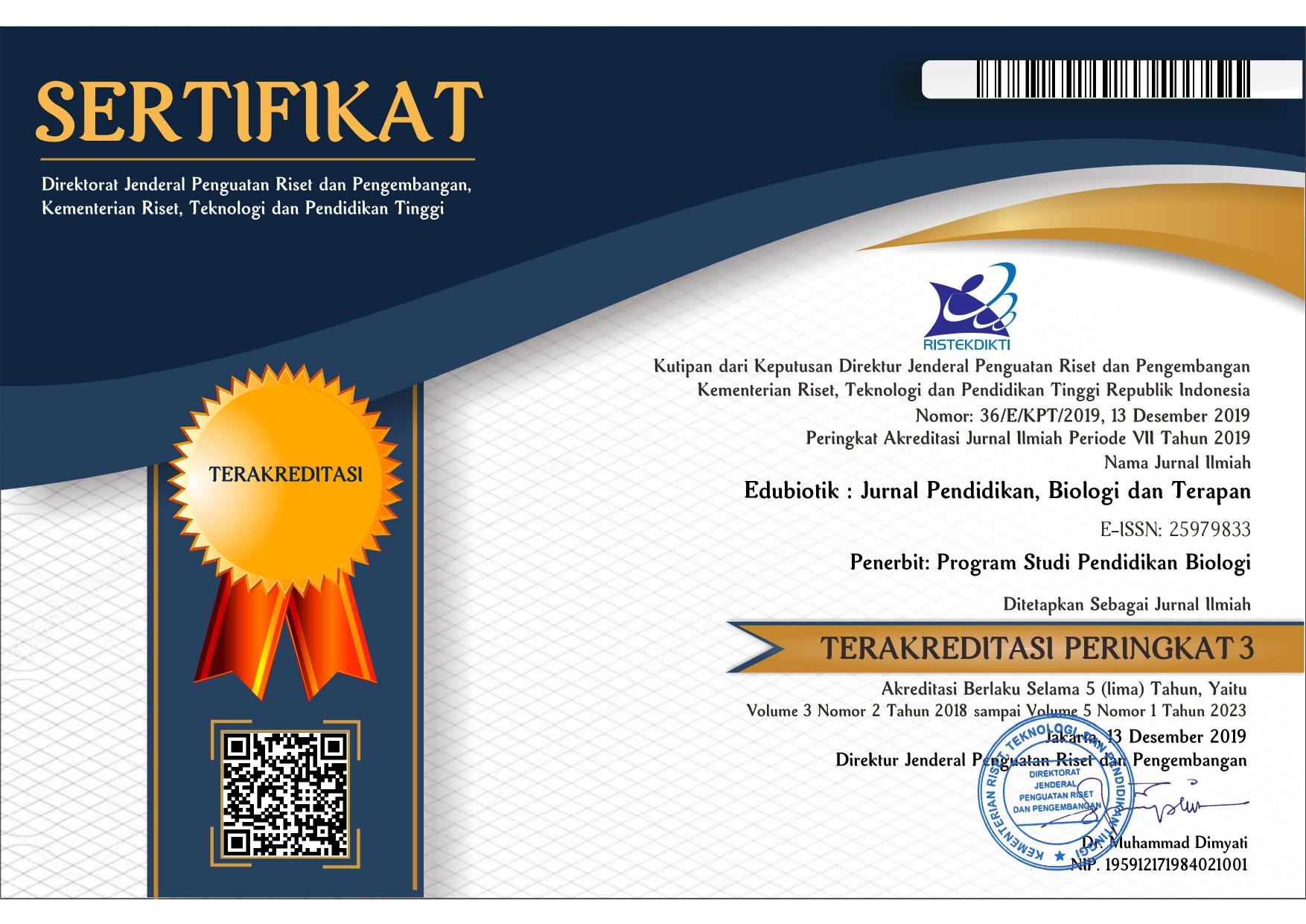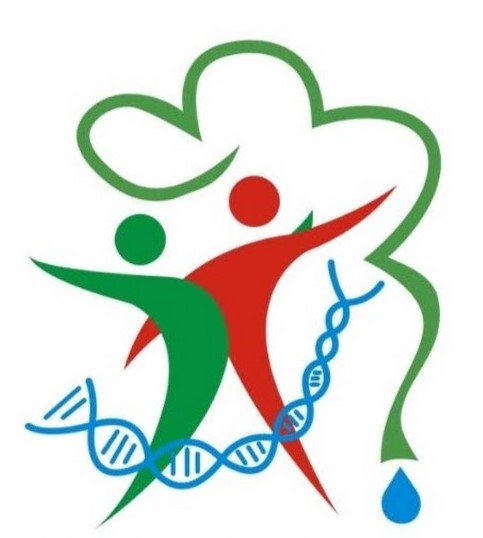Development of sets-based science e-module to improve critical thinking skills of grade viii students on additive and addictive substances material
Abstract
The critical thinking skills of junior high school students in Jember are still low, the existing learning is still teacher-centered, and the students lack initiative in asking questions. Based on the results of the national examination of additives and addictive substances, in the last five years, it is relatively low. Through these data, it is known that there are problems related to critical thinking, namely additives and addictive substances. The research aims to develop a SETS-based (Science, Environmental, Technology, and Society) science e-module on additive and addictive substances material to improve students’ critical thinking skills. This type of research is Research and Development (R&D) uses a 4D development model. The SETS-based science e-module on additive and addictive substances material developed was tested on research subjects, namely 23 students of class VIII-I, SMP Negeri 1 Jember. The research instruments include validation sheets, learning implementation sheets, pre-test, and post-test questions, and response questionnaires. The validation result of the development of SETS-based science e-module on additive and addictive substances material was stated as valid, with a score of 79%. The practicality of learning was stated with a score of 3.64%, with a very practical category. The N-gain test score of 0.81 with a high category, so that the SETS-based science e-module on additive and addictive substances material can improve students’ critical thinking skills. The results of the student's response questionnaires obtained a score of 89% in the very good category. Based on these data, the development of SETS-based science e-module on additive and addictive substances improves students’ critical thinking skills.
References
Afliansyah, E. P. (2022). Pengembangan modul pembelajaran IPA berbasis etnosains materi zat aditif dan adiktif untuk melatih literasi sains siswa SMP. UIN Fatmawati Sukarno Bengkulu. http://repository.iainbengkulu.ac.id/9042/
Akbar, S. (2013). Instrumen perangkat pembelajaran. PT. Remaja Rosdakarya Offset. https://opac.perpusnas.go.id/DetailOpac.aspx?id=860002
Akcay, B. , & Akcay, H. (2015). Effectiveness of science-technology-society (sts) instruction on student understanding of the nature of science and attitudes toward science. International Journal of Education in Mathematics, Science and Technology, 3(1), 37–45. https://www.ijemst .com/index.php/ijemst/article/view/51
Al-Shaye, S. (2021). Digital storytelling for improving critical reading skills, critical thinking skills, and self-regulated learning skills. Cypriot Journal of Educational Sciences, 16(4), 2049–2069. https://doi.org/10.18844/cjes.v16i4.6074
Arikunto, S. (2006). Dasar-dasar evaluasi pendidikan. Bumi Aksara. https://books.google.co.id/books/ about/Dasar_Dasar_Evaluasi_Pendidikan_Edisi_3.html?id=j5EmEAAAQBAJ&redir_esc=y
Arimadona, S. (2016). Pengembangan modul pembelajaran biologi berbasis integrasi islam sains. Jurnal Pendidikan Rokania, 1(2), 89–98. https://e-jurnal.stkiprokania.ac.id/index.php/jpr/article/view/71
Artiniasih, N. K. S., Agung, G. A. A., & Sudatha, I. G. W. (2019). Pengembangan elektronik modul berbasis proyek mata pelajaran ilmu pengetahua alam kelas viii sekolah menengah pertama. Jurnal EDUTECH, 7(1), 54–65. https://ejournal.undiksha.ac.id/index.php/JEU/article/view/20008
Chowdhury, M. A. (2016). The integration of science-technology-society/science-technology-society environment and socio-scientific-issues for effective science education and science teaching. Electronic Journal of Science Education, 20(5), 20–38. https://eric.ed.gov/?id=EJ1188220
Crockette, L. W. (2018, April 16). 28 Question stems that improve critical thinking ability. https://Www.Gspls.Vic.Edu.Au.
Doweiko, H. E. (2019). Concepts of chemical depedency. Cengange. https://www.cengageasia.com/
Facione, P. A. (2015). Critical Thinking: What It Is and Why It Counts. Measured Reasons LLC. https://www.insightassessment.com/article/critical-thinking-what-it-is-and-why-it-counts
Food and Agriculture Organization-World Health Organization. (2019, June 26). Codex alimentarius. general standard for food additives (Codex Stan 192-1995). http://Www.Fao.Org/Gsfaonline/Docs/CXS_192e.Pdf
Food and Drug Administration. (2021, August 26). Food additive status list. Https://Www.Fda.Gov/Food/Food-Additives-Petitions/Food-Additive-Status-List
Hake, R. R. (1998). Interactive-engagement versus traditional methods: A six-thousand student survey of mechanics test data for introductory physics courses. American Journal of Physics, 66(64). https://aapt.scitation.org/doi/10.1119/1.18809
Handayanti, A. , Rohmatika, L. , Ayudatami, I. A. , & Sari, S. N. (2018). Identifikasi keterampilan berfikir kritis peserta didik SMP di Kabupaten Jember. Prosiding Seminar Nasional Hasil Penelitian Dan Pengabdian Kepada Masyarakat 2018, 592–596. http://prosiding.lppm.unesa.ac.id/index.php/sem nasppm2018/article/view/48
Hudha, M. N. , & Batlolona, J. R. (2017). How are the physics critical thinking skills of the students taught by using inquiry-discovery through empirical and theoretical overview?. Eurasia Journal of Mathematics, Science and Technology Education, 14(2), 691–697. https://www.ejmste.com/ article/how-are-the-physics-critical-thinking-skills-of-the-students-taught-by-using-inquiry-discovery-5295
Kartina, A. A. , Sucianti, & Harlita. (2019). Analisis hasil ujian nasional materi zat aditif dan adiktif SMP di Surakarta. Seminar Nasional Pendidikan Sains, 162–167. https://www.researchgate.net/
Martins, F., Franco, D., Muñoz, R., & Souza, D. (2017). Compostos orgânicos e inorgânicos contendo selênio: Revisão de métodos analíticos e perspectivas para análises químicas. Química Nova. https://doi.org/10.21577/0100-4042.20170151
Munadi, Y. (2013). Media pembelajaran. Referensi (GP Press Group).
Nasution, N. A. (2016). Pengembangan bahan ajar berbasis model pembelajaran inkuiri untuk meningkatkan kemampuan komunikasi matematis dan self-regulated learning siswa SMP Negeri Panyabungan. Universitas Negeri Medan. http://digilib.unimed.ac.id/8179/
Nurlila, R. U. , & Fua, J. L. (2017). Penyalahgunaan zat adiktif pada siswa kelas VIII di Sekolah Menengah Pertama Negeri 05 Kota Kendari. Jurnal AL-Ta’dib, 10(1), 70–90. https://ejournal.iainkendari.ac.id/al-tadib/article/view/553
Nuryanti, L. , Zubaidah, S. , & Diantoro, M. (2018). Analisis kemampuan berpikir kritis peserta didik SMP. Jurnal Pendidikan: Teori, Penelitian, & Pengembangan, 3(2), 155–158. http://journal.um. ac.id/index.php/jptpp/article/view/10490
Octavia, S. , Yusmin, E. , & Nursangaji, A. (2015). Kemampuan berpikir kritis peserta didik berdasarkan aspek interpretation di sekolah menengah atas. Jurnal Pendidikan Dan Pembelajaran Khatulistiwa, 4(9), 1–12. https://jurnal.untan.ac.id/index.php/jpdpb/article/view/11318
Putri, S. R., & Syafrian. (2022). Pengembangan e-modul fisika berbasis sets (science, environment, techonogy, society) untuk meningkatkan kemampuan berpikir kritis peserta didik SMA/MA. Jurnal Penelitian Dan Pembelajaran Fisika, 8(2), 142–151. http://ejournal.unp.ac.id/index.php/jppf/article/view/119361
Ridho, M. H. , Wati, M. , & Mahtari, S. (2020). Validitas bahan ajar gerak melingkar berbasis authentic learning di lingkungan lahan basah untuk melatih keterampilan pemecahan masalah. Journal of Teaching and Learning Physics, 5(2), 87–98. https://journal.uinsgd.ac.id/index.php/jtlp/article/view/8453
Sa’diyyah, M. , Bambang S., & Paidi. (2016). Kemampuan berpikir divergen dalam keterampilan proses sains peserta didik SMA Negeri di Kabupaten Kulon Progo pada mata pelajaran biologi ditinjau berdasarkan latar belakang pendidikan guru. Jurnal Pendidikan Biologi, 5(7), 38–49. https://journal.student.uny.ac.id/index.php/jeb/article/view/4631
Saeed, S. J. G. M. , & Rousta, S. N. (2013). The effect of problem-based learning on critical thinking ability of iranian EFL students. Journal Of Academic and Applied Studies, 3(7), 1–14. http://academians.org/Articles/July2013-1.pdf
Saltmarsh, M. , & Insall, L. (2013, February 21). Essential guide to food additives. The royal society of chemistry. https://pubs.rsc.org/en/content/chapter/bk9781849735605-00001/978-1-84973-560-5
Setiawan, D. C. , Ni’mah, F. , & Karolina, W. (2021). Analysis of the need for development of e-module based on interactive media learning in the era of the pandemic. Edubiotik: Jurnal Pendidikan, Biologi Dan Terapan, 6(2), 132–138. https://doi.org/10.33503/ebio.v6i02.1358
Siahaan, R. , Sitorus, M. , & Silaban, S. (2021). The development of teaching materials oriented to critical thinking skills for chemistry class XI high school. Jurnal Pendidikan Kimia, 13(1), 60–68. https://www.researchgate.net/
Singh, J. , & Gupta, P. K. (2017). Drug addiction: Current trends and management. The International Journal of Indian Psychology, 5(1), 186-201. https://ijip.in/articles/drug-addiction-current-trends-and-management/
Siswanti, K. L., Nida, S., & Sugiyanto. (2021). Pengembangan bahan ajar IPA terpadu dengan model pembelajaran problem-based learning (pbl) pada materi zat aditif dan zat adiktif untuk siswa SMP/Mts Kelas VIII. Jurnal MIPA Dan Pembelajarannya, 1(5), 347–355. http://journal3.um.ac.id/index.php/mipa/article/view/323/295
Sufiyah, L. , & Sumarsono, H. (2015). Pengembangan media pembelajaran modul elektronik interaktif pada mata pelajaran ekonomi untuk kelas X lintas minat ekonomi SMA laboratorium UM Kota Malang. Jurnal Pendidikan Ekonomi, 8(2), 64–74. http://journal.um.ac.id/index.php/jpe/article/view/8781/4226
Thiagarajan, S., Semmel, D. S., & Semmel, M. I. (1974). Instructional development for training teachers of exceptional children a source book. ERIC. https://eric.ed.gov/?id=ED090725
Umami, R., & Jatmiko. (2013). Penerapan model pembelajaran inkuiri dengan pendekatan sets (science, environment, technology and society) pada pokok bahasan fluida statis untuk meningkatkan keterampilan berpikir kritis siswa kelas XI SMA Negeri 1 Gedangan. Jurnal Inovasi Pendidikan Fisika, 2(3), 61–69. https://jurnalmahasiswa.unesa.ac.id/index.php/5/article/view/3553
Vakili, M. M. , & Jahangiri, N. (2018). Content validity and reliability of the measurement tools in educational, behavioral, and health sciences research. Journal of Medical Education Development, 10(28), 106–118. https://zums.ac.ir/edujournal/browse.php?a_id=961&sid=1&slc_lang=en
Winarti, Y. , Indriyanti, D. R. , & Rahayu, E. S. (2015). Pengembangan bahan ajar ekologi kurikulum 2013 bermuatan sets melalui penerapan model problem based learning. Unnes Science Education Journal, 44(1), 1070–1078. https://journal.unnes.ac.id/nju/index.php/LIK/article/view/6665
Zendrato, J. (2016). Tingkat penerapan rencana pelaksanaan pembelajaran dalam pelaksanaan pembelajaran di kelas suatu studi kasus di SMA Dian Harapan Jakarta. Jurnal Pendidikan Dan Kebudayaan, 6(2), 58–73. https://ejournal.uksw.edu/scholaria/article/view/229
Zubaidah, S., Mahanal, S., Yuliati, L., Dasna, I.W., Pangestuti, A.A., Puspitasari, D.R., Hamim T., Mahfudhillah, Robitah, A., Kurniawati, Z.L., Rosyida, F., & Sholihah M. (2017). Ilmu pengetahuan alam. Kementerian Pendidikan dan Kebudayaan. https://www.researchgate.net/





.png)
2.png)

1.jpg)


